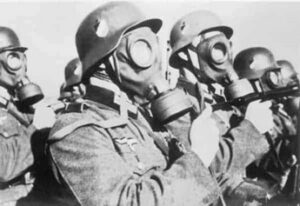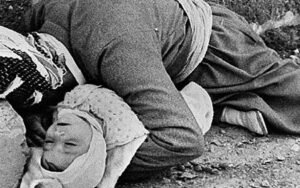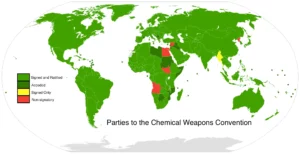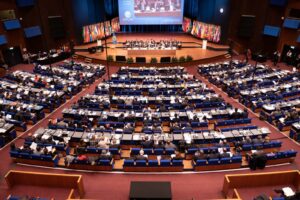In the early evening on April 22nd, 1915, over Ypres in Belgium, Allied soldiers of the Western Theatre prepare their offensive positions for the night’s combat. A dense fog rolls across the battle ridden ground of no-man’s land as the Allied troops prepare their stations. During WWI’s deadly futility of trench warfare, the stalemate of combat between the two sides brought daily struggles which resulted in a tense standoff, with neither side gaining any ground. That evening, a thick fog rolls in and blinds the allies from focusing their weapons on any movement across the line. However, this was no ordinary fog of dew and water vapor, this lethal thick cloud contains 150 tons of chlorine gas that envelopes the trench, searing the eyes, lungs, and skin of the allies, sending them into a panic, and decimating their ranks. With no other option but to frantically run for their life, or let their bodies burn inside and out, the Allied troops scrambled to their death. The Germans had just deployed the largest chemical weapon attack of all time.1
The heinous and reckless dispersion of chemical weapons during World War I inflicted a grim toll of death and suffering upon soldiers and civilians alike. Nearly 90,000 fatalities occurred among soldiers who perished as a direct effect of chemical weapons exposure. Introduced as a new form of warfare, chemical agents such as chlorine, phosgene, and mustard gases inflicted horrific injuries, leading to agonizing deaths for thousands of individuals. These chemical agents were specifically designed by scientists throughout the war to create unavoidable and devastating effects on soldiers. The most famous of which because of its easy deployment method, Mustard Gas was known for its grisly deaths. Mustard Gas did not require large canisters to be deployed, and instead could be shot as artillery shells, thrown as a grenade, or sprayed from an aircraft unleashing its pain and suffering on its unsuspecting victims. First, the contact of the gas vapors on the skin or mucous barriers created painful blisters.

These blisters covered the body of the victims, with the boils and blisters on the skin a fundamental sign of the symptoms of mustard gas deaths. In addition, the inhalation of mustard gas was equally as devastating since this chemical agent caused deep burns and blistering inside the respiratory system of its victims. The searing of the inner linings of the lungs and path of the respiratory system would initially start as a cough and shortness of breath, but quickly become fatal as the prolonged exposure led to chronic respiratory disease and eventual lung failure and death.2 However, the use of these weapons not only caused immediate fatalities but also left a lasting legacy of physical and psychological trauma among survivors. If an individual was so lucky as to live through the effects of mustard gas, or other chemical weapons, they were still inundated by the increased likelihood of lung and respiratory cancers later in life by the carcinogenic properties of the weapons. In this way, the death toll of such chemical weapons is even larger than can be measured by the immediate death counts of them, resulting in an estimated 1.3 million deaths during WWI.3 Therefore, the indiscriminate nature of chemical attacks exacerbated the already immense human cost of the conflict, underscoring the devastating consequences of technological innovation in the pursuit of military advantage. While Mustard Gas had first been synthesized before the war, its truly catastrophic effects were realized by its use in the war. Simply put, the widespread horror and revulsion provoked by the use of chemical weapons in World War I played a significant role in shaping international efforts to ban their use in subsequent conflicts. These instances would go on to launch an immediate effort following the end of WWI in 1918 against their use entirely and strengthened the call for a chemical weapons ban.
The “1925 Protocol for the Prohibition of the Use of Asphyxiating, Poisonous or Other Gases, and the Bacteriological Methods of Warfare” (AKA 1925 Geneva Protocol) stands as a pivotal milestone in the global efforts to prohibit the use of chemical and biological weapons in warfare.4 The 1925 Geneva Protocol or international agreement aimed to mitigate the horrors witnessed during World War I. It banned the use of chemical and biological agents in armed conflicts. Its significance lies not only in its prohibition of these weapons but also in establishing a framework for multilateral cooperation and accountability in upholding these humanitarian norms. The resulting treaty was signed by 16 of the world’s largest powers, but fundamentally lacked the agreement of many of the world’s nations. However, the 1925 Geneva Protocol, while undoubtably necessary in the grand scheme of international law prohibiting the use of chemical agents, would prove to be unable to stop the widespread use of chemical agents alone.5 Despite the convention, the use of chemical weapon agents persisted beyond 1925, including the infamous chemical weapons attack by Saddam Hussein on March 16, 1988.
In the midst of the Iran-Iraq War, from 1980 to 1988, the town of Halabja, a predominantly Kurdish town located in northeastern Iraq near the border with Iran, was targeted by the regime of Saddam Hussein. In a heinous display of the devastating power of chemical weapons, an estimated 5000 Halabja residents were murdered by a variety of chemical weapons administered by the Saddam Hussein regime.6

The majority of these individuals were civilians, including thousands of innocent women and children. In addition, thousands more suffered severe injuries, with survivors enduring long-term health consequences, including respiratory problems, neurological disorders, and various forms of cancer. Despite the already abhorrent destructive powers of Mustard Gas, the regime went a step further by using the nerve agents Sarin and VX. These chemical nerve agents, Sarin and VX, are liquid chemical weapons that, like Mustard Gas, display their effects when touched or inhaled. However, unlike Mustard Gas, nerve agents like Sarin and VX can be fatal with exceptionally small amounts of exposure. In the case of Sarin, just tens of milligrams of the liquid can cause paralysis, convulsions, respiratory failure, and death extremely quickly. The despicable concoction of chemical weapons by Saddam Hussein’s regime ravaged the town of Halabja.7 Unfortunately, the Geneva Protocol, in its very inception, was designed to prohibit these sorts of attacks in theory, yet it had no provisions that could physically preempt or punish the actions of such regimes like Saddam Hussein. What the Geneva Protocol accomplished in theory, it lacked in enforcement, where the absence of specific punitive measures meant that tragedies like this could happen without a collective global effort to punish the transgressors.
Another example of persistent chemical weapon’s effects is that of the Matsumoto Sarin Attack on June 27, 1994. Aum Shinrikyo, a Japanese Cult, released sarin gas in the city of Matsumoto, Nagano Prefecture, Japan. The attack targeted residents of a residential complex known as Tsukimi Village, where three judges were residing. The cult aimed to eliminate these judges who were presiding over a court case involving Aum Shinrikyo. In doing so, the attack killed eight people and injured more than 200, making it one of the deadliest acts of domestic terrorism in Japan up to that time. In addition, less than a year later, on March 20, 1995, the Tokyo Subway Sarin Attack would occur. Like the previous incident, the Aum Shinrikyo cult was responsible for this act of terror in Japan. This time however, the Aum Shinrikyo orchestrated a more widespread sarin gas attack in the Tokyo subway system during rush hour. Members of the cult boarded several trains on different subway lines and simultaneously released bags containing liquid sarin, which they punctured with umbrella tips and left on the train floors before exiting. The attack resulted in the deaths of 13 people and affected thousands more who suffered various degrees of injury, including respiratory distress, vision problems, and neurological damage.8
While these two acts of terror carry a significantly smaller death toll than wartime widespread use of chemical weapons, they demonstrate the relevance of the danger chemical weapons represent despite the 1925 Geneva Protocol. In this case, a cult organization was able to get their hands on a chemical weapon and use it to cause widespread acts of violence, highlighting another key shortcoming of the Geneva Protocol. In particular, while the Geneva Protocol called for the prohibition of use of various chemical weapons, it failed to address the production, manufacture, or development of chemical weapons. In other words, while the Geneva Protocol was hugely impactful in tackling the effects of chemical weapons, it neglected to fight the root cause of them. Therefore, the effort for another international treaty against chemical weapon use, and production, was launched in 1992. This is because it would not be until the fall of the former USSR on December 26, 1991, when mutual support for chemical weapons ban would be agreed upon by the United States and Russia. During the time of the Cold War, the military tension between the US and the USSR included the stockpiling of chemical weapons, and support for a chemical weapons ban would be contrary to the nation’s practices. As a result, mutual agreement to reduce chemical weapons stockpiles following the dissolution of the USSR contributed to transition from international support for chemical weapons ban to international action.9
The Chemical Weapons Convention (CWC for short), administered by the Organization for the Prohibition of Chemical Weapons (OPCW) in The Hague, Netherlands, opened into force on April 29, 1997, and served to provide a more comprehensive ban against chemical weapons. Most notably, the convention not only called for the prohibition of the use of chemical weapons, but it also directly outlined a ban against the development, production, and stockpiling of such weapons. What the Geneva Protocol lacked in its original writing, the CWC provided an encompassing ban against all instances of chemical weapon existence. Furthermore, the CWC went a step further by establishing a framework for the verification and destruction of existing chemical weapons stockpiles across the world. From its initial signing date to when it came into effect in 1997, a total of 130 nations signed the convention, including major world powers such as the United States, Russia, China, the United Kingdom, France, Brazil, South Africa, Nigeria, and Germany to name a few.10 As a result, the CWC represents the culmination of the international recognition and fight against chemical weapons production and use by over half of the entire world’s nations.11

Nonetheless, the treaty is not without controversy, as a fundamental principle of the CWC is that it itself doesn’t carry the weight of law in individual countries. Instead, countries that are parties to the convention are required to enact domestic legislation to implement its provisions and fulfill their obligations under the treaty through their own jurisdictions. That being said, unlike the United Nations, there is no international military power that enforces the provisions of the convention.
Instead, each nation signatory to the treaty must uphold its provisions. So, while the CWC, as an international treaty, does not itself carry the weight of law, the laws enacted by member states to comply with the treaty do carry legal weight within their respective jurisdictions. Therefore, the CWC is a successful international law, which, simply put, has contributed to a drastic reduction in the contemptible use of chemical weapons.

However, as with most facets of international law, it is not absolute. In other words, while the CWC and other international documents aim to be all encompassing and completely solve the problem at hand, they seldom do so entirely. Namely, instances still exist today where chemical weapons are abused by bad actors throughout the world. For example, the Syrian Civil War, which began in 2011 and still persists today, represents a current day conflict in which the use of chemical weapons has been documented throughout. As already mentioned with the CWC, the ability of international actors to stop these instances of defiance remains limited only through self-accountability of each nation to uphold the provisions of the convention. In this way, to claim that the issue of chemical weapons is one of the past would be simply incorrect. Nonetheless, there has been significant and concrete improvements since WWI that can be attributed to the international law documents of the Geneva Protocol and CWC. As a result, while people around the world can rejoice in the absence of widespread chemical weapon attacks, they must remain vigilant as chemical weapons have not disappeared, nor has the willingness of specific actors diminished in their interest of harnessing the power of these weapons.
- D. Roos, (2021, May 17), How the shocking use of gas in World War I led nations to ban it, History.com.https://www.history.com/news/world-war-i-gas-chemical-weapons. ↵
- K. Stewart, (2024, February 29). mustard gas. Encyclopedia Britannica. https://www.britannica.com/science/mustard-gas. ↵
- Fitzgerald G. J. (2008). Chemical warfare and medical response during World War I. American journal of public health, 98(4), 611–625. https://doi.org/10.2105/AJPH.2007.11930. ↵
- 1925 geneva protocol. United Nations Office for Disarmament Affairs. (n.d.). https://disarmament.unoda.org/wmd/bio/1925-geneva-protocol/. ↵
- 1925 Geneva Protocol. United Nations Office for Disarmament Affairs. (n.d.). https://disarmament.unoda.org/wmd/bio/1925-geneva-protocol/. ↵
- BBC. (2013, March 16). Iraqi Kurds Mark 25 Years Since Halabja Gas Attack. BBC News. https://www.bbc.com/news/world-middle-east-21814734. ↵
- U.S. Department of State. (n.d.). Saddam’s Chemical Weapons Campaign: Halabja, March 16, 1988. U.S. Department of State. https://2001-2009.state.gov/r/pa/ei/rls/18714.htm. ↵
- The sarin gas attack in Japan and the related forensic investigation. OPCW. (n.d.). https://www.opcw.org/media-centre/news/2001/06/sarin-gas-attack-japan-and-related-forensic-investigation. ↵
- Encyclopædia Britannica, inc. (n.d.). Chemical Weapons Convention. Encyclopædia Britannica. https://www.britannica.com/event/Chemical-Weapons-Convention. ↵
- Chemical Weapons Convention. OPCW. (n.d.-a). https://www.opcw.org/chemical-weapons-convention. ↵
- Michael Blake for Technology Concepts and Design, Inc. (2001, January 1). United States Chemical Weapons Convention – Treaty – Article index. United States Chemical Weapons Convention Web Site. https://www.cwc.gov/cwc_treaty_articles.html. ↵




4 comments
Maria Fernanda Guerrero
Your article about the detailed impact of chemical weapons throughout history is both enlightening and harrowing. Reading through the accounts of these horrific attacks truly resonates with international law since it helps prevent such atrocities. Your meticulous research and vivid descriptions shed light on the grim realities faced by those affected by chemical warfare. Thank you for your insightful and engaging article and congratulations on your nomination!
Martin Martinez
It’s a bit absurd to me that chemical weapons (like tear gas) are prohibited by the Geneva Conventions, but are legal in their use on civilians.
This article nonetheless does well to highlight that politics is always reactionary. I cannot imagine what modern warfare would look like if those countries who now comply with the Chemical Weapons Convention did not. Nuclear and chemical resources are always here; we walk on a very thin line.
Leaya Valdez
Hello Jonathan! Very interesting topic to read about, I’ve never fully knew that they have been using chemical weapons in war for many decades. It captures all sides of the story of how both sides feel about using chemical weapons, that can also be a way that people reading this article can hold discussions as well and see where they stand too. Great job on the article!
Esmeralda Gomez
Hi Jonathan! First off, amazing topic, secondly, what an excellent read to find myself thoroughly enjoying. The use of chemical weapons has had a very long and detrimental history to everyone who has used them, and this article perfectly encapsulates the troubles of those who were comfortable with using them and the outcome of that usage. Amazing job and I wish you luck with your nomination!